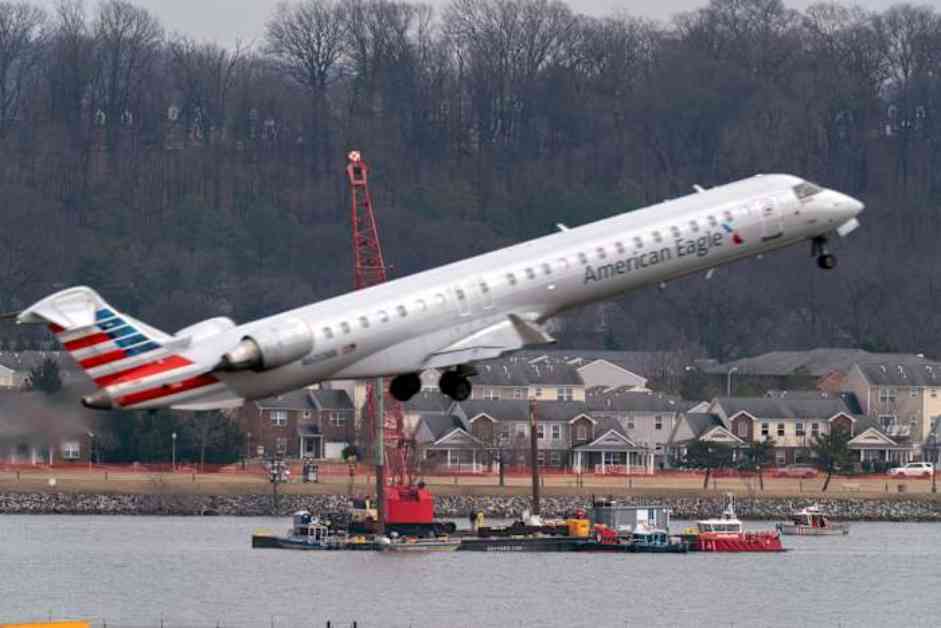The tragic midair collision between an American Airlines jet and a Black Hawk helicopter near Ronald Reagan Washington National Airport has left investigators puzzled. The National Transportation Safety Board (NTSB) revealed that the helicopter crew may not have heard crucial instructions from the air traffic controller, leading to the fatal accident that claimed the lives of all 67 individuals aboard the two aircraft.
NTSB Chairwoman Jennifer Homendy disclosed that the cockpit recording from the Black Hawk helicopter indicated that the crew possibly missed a critical directive just before the collision on January 29. The helicopter was on a routine check flight that night, with the pilot undergoing testing on night vision goggles and instrument flying. It is believed that the crew was utilizing night vision goggles throughout the flight, adding a layer of complexity to the situation.
This heartbreaking incident marks the deadliest plane crash in the United States since 2001, when a tragic jet crash in New York City claimed the lives of 260 individuals on board and five more on the ground. The NTSB’s findings shed light on the potential communication breakdown between the air traffic controller and the helicopter crew, highlighting the importance of clear and concise instructions in high-pressure situations.
Communication Breakdown: A Fatal Oversight
According to Homendy, the Black Hawk crew did not hear the crucial words “pass behind the” during the transmission from the controller due to a microphone key being inadvertently depressed at that moment. This oversight had catastrophic consequences, underscoring the critical nature of effective communication protocols in aviation.
During the flight leading up to the collision, there was a discrepancy between the pilot and the instructor pilot regarding the helicopter’s altitude. While the pilot stated the Black Hawk was at 300 feet, the instructor pilot insisted it was at 400 feet, raising questions about the accuracy of altitude readings and potential factors contributing to the miscommunication.
As experts continue to analyze the sequence of events that led to the tragic collision, the NTSB emphasizes the importance of thorough investigations and improved safety measures to prevent similar incidents in the future. The aviation community mourns the loss of lives in this devastating accident, prompting a renewed focus on training, communication protocols, and pilot awareness to enhance safety standards across the industry.
Lessons Learned: Enhancing Aviation Safety
In the wake of this heartbreaking tragedy, aviation authorities are reevaluating existing safety protocols and communication procedures to mitigate the risk of similar accidents. The NTSB’s investigation serves as a sobering reminder of the critical role that effective communication plays in ensuring the safety of air travel.
As passengers, we place our trust in the hands of skilled pilots and air traffic controllers every time we board a plane, relying on their expertise to navigate the skies safely. The insights gained from this investigation underscore the need for continuous training, vigilance, and adherence to established protocols to prevent lapses in communication that could have catastrophic consequences.
In memory of the lives lost in this tragic collision, the aviation industry is committed to learning from this experience and implementing measures to enhance safety standards and prevent future accidents. By fostering a culture of accountability, transparency, and collaboration, we can honor the memory of those who perished and strive to make air travel safer for all passengers and crew members alike.
The investigation into the midair collision between the American Airlines jet and the Black Hawk helicopter near Ronald Reagan Washington National Airport continues, with authorities working tirelessly to uncover the root causes of this devastating incident. As we reflect on the lessons learned from this tragedy, let us remain vigilant and united in our commitment to enhancing aviation safety and preventing similar accidents in the future.















